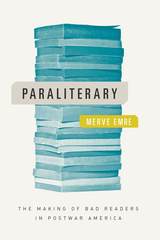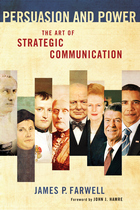
We should, Emre argues, think of such readers not as non-literary but as paraliterary—thriving outside the institutions we take as central to the literary world. She traces this phenomenon to the postwar period, when literature played a key role in the rise of American power. At the same time as American universities were producing good readers by the hundreds, many more thousands of bad readers were learning elsewhere to be disciplined public communicators, whether in diplomatic and ambassadorial missions, private and public cultural exchange programs, multinational corporations, or global activist groups. As we grapple with literature’s diminished role in the public sphere, Paraliterary suggests a new way to think about literature, its audience, and its potential, one that looks at the civic institutions that have long engaged readers ignored by the academy.

Now more than ever, in the arenas of national security, diplomacy, and military operations, effective communication strategy is of paramount importance. A 24/7 television, radio, and Internet news cycle paired with an explosion in social media demands it.
According to James P. Farwell, an expert in communication strategy and cyber war who has advised the U.S. SPECIAL OPERATIONS COMMAND and the Department of Defense, and worked nationally and internationally as a media and political consultant, this book examines how colorful figures in history from Julius Caesar to Winston Churchill, Napoleon to Hugo Chavez, Martin Luther to Barack Obama and Ronald Reagan, have forged communication strategies to influence audiences.
Mark Twain said that history doesn't repeat itself, but rhymes. In showing how major leaders have moved audiences, Farwell bears out Twain's thesis. Obama and Luther each wanted to reach a mass audience. Obama used social media and the Internet. Luther used the printing press. But the strategic mindset was similar. Hugo Chavez identifies with Simon Bolivar, but his attitude towards the media more closely echoes Napoleon. Caesar used coins to build his image in ways that echo the modern use of campaign buttons. His "triumphs," enormous parades to celebrate military victories, celebrated his achievements and aimed to impress the populace with his power and greatness. Adolph Hitler employed a similar tactic with his torchlight parades.
The book shows how the US government's approach to strategic communication has been misguided. It offers a colorful, incisive critical evaluation of the concepts, doctrines, and activities that the US Department of Defense and Department of State employ for psychological operations, military information support operations, propaganda, and public diplomacy.
Persuasion and Power is a book about the art of communication strategy, how it is used, where, and why. Farwell's adroit use of vivid examples produce a well-researched, entertaining story that illustrates how its principles have made a critical difference throughout history in the outcomes of crises, conflicts, politics, and diplomacy across different cultures and societies.
READERS
Browse our collection.
PUBLISHERS
See BiblioVault's publisher services.
STUDENT SERVICES
Files for college accessibility offices.
UChicago Accessibility Resources
home | accessibility | search | about | contact us
BiblioVault ® 2001 - 2024
The University of Chicago Press









